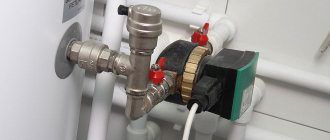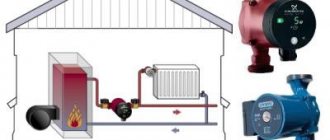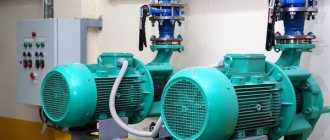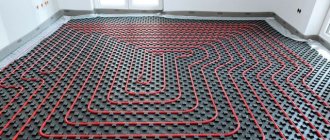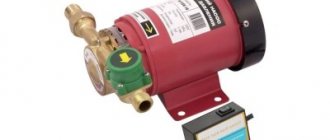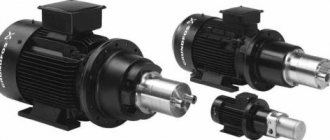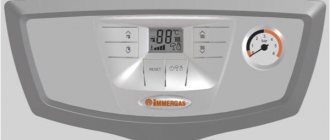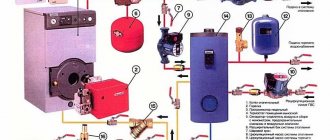A circulation pump is most often installed in autonomous heating systems to ensure constant circulation of coolant through the pipes. This allows thermal energy to be evenly distributed throughout all rooms and used efficiently. Using a circulation pump in a private home allows you to warm up all the rooms in a short time, and then constantly maintain a comfortable temperature by adjusting the performance.
The correct choice of a circulation pump allows you to reduce energy costs by almost a third. Therefore, when purchasing equipment, you should either pre-calculate the required operating parameters or seek help from specialists.
- Design and operating principle
- Types of circulation pumps
- How to choose the right pump
- Marking of circulation pumps
Design and operating principle
The circulation pump, regardless of its type, consists of the following components:
- housing made of corrosion-resistant materials;
- an electric motor consisting of a stator winding and a rotating rotor;
- wheels with blades (impellers) connected to the drive shaft.
When power is applied to the stator winding, the rotor begins to rotate and transmits torque to the impeller. The latter, rotating in the working chamber, creates a vacuum in the heating main, which leads to the suction of water from the pipeline. The coolant that enters inside creates excess pressure and is pushed into the discharge pipe of the heating system. Thanks to the pressure, hot water enters the pipes and radiators and circulates freely through them, overcoming the force of friction.
Types and main characteristics
Before understanding the technical characteristics of circulation pumps for heating systems, you should become familiar with the different types of such equipment. According to their design, circulation pumps are divided into:
The design feature of devices of the first type is that the moving elements of their rotor assembly are constantly in contact with the pumped medium, which ensures not only their lubrication, but also effective cooling. In addition, the operation of such equipment, the rotor of which is constantly located in a liquid medium that perfectly absorbs all vibrations, is characterized by a minimal noise level. The advantages of circulation pumps with a “wet” rotor are also their compact size, ease of installation and maintenance. If we talk about the disadvantages of such hydraulic machines, the most significant of them is low efficiency.
Design of a circulation pump with a “wet” rotor
In circulation pumps with a “dry” rotor, as is clear from their name, the elements of the rotor assembly do not contact the liquid coolant, which gives such devices both advantages and disadvantages. The most significant advantages of hydraulic machines of this type are high productivity and efficiency, reaching up to 80%. Circulation pumps with a dry rotor are equipped with powerful thermal stations and heating systems for industrial use; as a rule, they are not used in domestic heating systems. Among the disadvantages of hydraulic machines with a “dry” rotor, they usually mention the rather high noise level, as well as the complexity of installation and maintenance.
Design of a circulation pump with a dry rotor
The technical capabilities and operating conditions of circulation pumps for heating systems are determined by a number of characteristics.
This parameter indicates the amount of liquid that the device is able to pump per unit of operating time. The unit of measurement for this parameter is m 3 /hour.
Pressure is also called hydraulic resistance. The amount of pressure generated by the circulation pump is measured in meters or decimeters of water column.
To pump an increased volume of coolant, dual circulation pumps are used
The type of electrical network (single- or three-phase) to which the pump can be connected depends on this parameter. Naturally, for installation in heating systems of residential buildings, you should choose hydraulic machines operating from an electrical power supply with a voltage of 220 V.
This characteristic depends both on the specific model of pumping equipment and on the mode in which it operates. Many models of circulation pumps designed for domestic heating systems can provide several speeds of pumping water. On the body of such pumps, as a rule, there is a special plate on which the power consumption and current strength corresponding to each operating mode are indicated. The vast majority of circulation pumps for domestic heating systems are characterized by power consumption in the range of 50–70 W.
Table 1. Main parameters and features of choosing circulation pumps for heating
Maximum coolant temperature
When choosing a circulation pump for a heating system according to this parameter, you should give preference to models designed to work with a working environment whose temperature can reach up to 110°.
This includes such characteristics as the diameter of the threaded part of the mounting elements of pumping equipment and the installation length of its body. Most of the circulation pumps used in domestic heating systems are simply cut into the pipeline and connected to its elements using union nuts - “American women”. Quite often, both the nuts themselves and the pipes for connecting the device to the pipeline system are already included in its factory configuration. The most common mounting diameters of circulation pumps used to equip domestic heating systems are 1 and 1.25 inches (25 and 32 mm, respectively). The installation length of household circulation pumps can be 130 or 180 mm.
All dimensional parameters of the pump are indicated in its technical data sheet
Electrical protection class
Most modern models of circulation pumps for domestic heating systems according to the international classification correspond to IP44 protection class. Manufacturers provide pumping equipment of this class with protection against the entry of solid foreign particles larger than 1 mm into its interior. This is indicated by the first number 4 in the marking. The next number 4 in the designation of the protection class means that the electrical part of the equipment is insured against liquid drops and splashes flying at any angle.
Maximum fluid outlet pressure
On the housing of many models of circulation pumps you can find information about this characteristic. As a rule, for household equipment this parameter does not exceed 10 bar. From a practical point of view, it doesn’t mean anything; characteristics such as pressure and productivity are much more important.
Brand and manufacturing company
When choosing circulation pumps for heating systems (as well as any other technical devices), it is better to give preference to products from well-known manufacturers who take quality issues more seriously and provide reliable guarantees.
Table 2. Some models of Russian circulation pumps
Table 3. Some models of circulation pumps from the international company NeoClima
Technical characteristics of circulation pumps for heating systems are usually included in the designation of their models. Using such designations, in particular, you can immediately determine the following parameters: the liquid pressure created by the device, the diameters of its suction and discharge pipes, and the installation length.
Types of circulation pumps
With wet rotor. In such equipment, the pumped liquid is the lubricant and coolant. Wet-type circulation pumps have an efficiency of about 50% and are practically silent, therefore they are often installed in heating systems of private houses. The models have a function for controlling the speed of coolant pumping and are designed for three operating modes. Thanks to this, the user can set the most comfortable heating level for himself.
With dry rotor. Such circulation pumps have more power than wet ones. The rotor is located in a sealed compartment and does not come into contact with the coolant. The efficiency of a dry pump reaches 80%, but its noise level is also quite high. Therefore, such equipment is rarely installed in autonomous heating systems, except in free-standing mini-boiler rooms.
Grundfos ups pump technical specifications
Technical characteristics of the grundfos UPS pump are presented in the catalog in the documentation section. Below we propose to consider a summary field of hydraulic characteristics.
We would like to give fairly banal advice that it is better to buy a Grundfos UPS pump in a specialized store from an official dealer. There are many fakes on the markets where Grundfos is easily confused with low-quality manufacturers. Counterfeits of Grundfos UPS pumps are indistinguishable to non-specialists, so be wise and do not fall for the tricks of scammers. The video highlights the typical differences between the original and the fake:
Grundfos not only takes care of promoting products on the market by expanding the dealer network, but also creates conditions for warranty support. When purchasing a Grundfos UPS pump, the buyer can always count on technical support.
How to choose the right pump
Equipment installed in the heating system must comply with its operating characteristics. If the model is selected incorrectly, the room temperature will be uncomfortable - too high or too low.
The main selection parameters are:
- connection diameter. To determine it, it is enough to measure the pipes in the heating system. Standard connection diameters are 1” (25 mm) and 1¼” (32 mm);
- installation length. It is indicated in the marking of the circulation pump and can be 130 or 180 mm. Selected in accordance with the location and features of equipment installation;
- pressure To determine it, you need to know the total length of the heating circuit. For every 10 m of the system there should be about 0.6 m of head water column. If the circuit length does not exceed 80 m, one pump will usually be sufficient;
- equipment performance. It is calculated using the formula Q = N/(T2-T1). Q - productivity, N - power (kW), T2 - outlet temperature (+90...+95 oC) and T1 (+60...+70 oC) - at the boiler inlet.
Selecting a circulation pump for heating
Circulation pumps allow you to get rid of the problems that arise in systems with natural circulation of coolant.
In thermal systems with a circulation pump, good circulation of coolant in heating devices is ensured, the boiler can be located in any location, and pipes of a smaller diameter can be used than in systems with natural circulation. The choice of a circulation pump is a task that must be solved when designing a system with forced circulation. What parameters should you use to choose a circulation pump for a heating system? What brand of pump to choose . We will try to answer these questions in today's article.
First of all, the circulation pump must be designed for heating systems, that is, it must withstand high temperatures (up to 110 degrees C) and operate on water or other coolants used in heating systems.
Then you need to decide on the technical characteristics of the pump itself. The most important of them are pressure and supply . You can find out what these concepts mean in the article Pressure, flow and pump power.
In order to correctly select the technical parameters of the pump, use its characteristics - a special graph reflecting changes in pressure and flow. This graph shows the hydraulic characteristics of the system , determined by its hydraulic resistance. The intersection of these graphs will determine the operating point, which will indicate what flow and pressure the pump will provide in a given system.
However, manufacturers do not always publish pump characteristics in the form of graphs, but only provide nominal and limiting operating parameters. In addition, difficulties may arise in determining the hydraulic characteristics of the system. For these reasons, pump selection is often carried out based on rated flow and maximum head .
How to determine the required flow of a circulation pump in a heating system
The flow (performance) of a pump is the amount of liquid transferred through its outlet per unit of time. You can estimate the required pump flow using the relationship:
If you want to approximately determine the required pump flow, you can use the rule: in one hour the pump must pump a volume equal to three volumes of the entire heating system . You should choose a pump that provides a margin of 10-20% in terms of productivity.
How to determine the required pressure of the circulation pump
The head of centrifugal pumps is most often expressed in meters. The pressure value allows you to determine what hydraulic resistance it can overcome. In a closed heating system, the pressure does not depend on its height, but is determined by hydraulic resistance. To determine the required pressure, it is necessary to perform a hydraulic calculation of the system. In private homes, when using standard pipelines, as a rule, a pump that develops a pressure of up to 6 meters is sufficient .
You should not be afraid that the selected pump is capable of developing greater pressure than you need, since the developed pressure is determined by the resistance of the system, and not by the number indicated in the passport. If the maximum pressure of the pump is not enough to pump liquid through the entire system, there will be no circulation of liquid, so you should choose a pump with a headroom reserve
.
What do the numbers mean in the designation of the circulation pump?
Usually the name of the circulation pump is followed by numbers, for example Compass 25-60. The first number indicates the rounded diameter of the pipes, and the second number indicates the pressure in decimeters.
Pump brand
If you have decided on the characteristics, then all you have to do is choose the brand of circulation pump. We offer several of the most famous brands.
Compass pumps from Gilex
JILEX company is a well-known manufacturer of centrifugal, vortex, submersible pumps and pumping equipment. The company's production is located in Russia in Klimovsk, Moscow region. The advantage of Gilex pumps is good quality and reasonable prices.
Characteristics of pumps Compass
The figures below show tables with the most important characteristics of Compass pumps. Pumps of this brand have a switch that allows you to obtain different characteristics.
Pumps Gilex Tsirklu 25-40, 25-60, 25-80
Pump with connecting union nuts 1 inch. The pump head is 4m, 6m and 8m respectively.
Pumps Gilex Tsirklu 32-40, 32-60, 32-80
Compass pumps with a head of 4m, 6m and 8m respectively.
Circulation pumps Grundfos (Grundfos)
Grundfos is a Danish pump manufacturing company known throughout the world. Grundfos pumps are somewhat more expensive than some of their analogues, but when buying a Grundfos pump you can rest assured of the quality and reliability of the unit.
Grundfos UPS 25-40, 25-60, 25-80
Grundfos pumps are small-sized, low-noise and economical.
Grundfos UPS 32-40, 32-60, 32-80
Grundfos pumps are highly economical and reliable.
What are circulation pumps for?
Circulation pumps are installed in heating systems with forced circulation of coolant . Actually, pumps provide this circulation. In systems with forced circulation, you can use pipes of smaller diameter than in systems with natural circulation, which allows you to save on installation of the heating system. In addition, with forced circulation of coolant in the system, devices can be installed to regulate the temperature in the room.
How to buy a circulation pump for heating
In order to purchase the pump you are interested in, click on its image , you will be redirected to the Cotmarket online store, where you will need to register and make a purchase. Payment can be made using a bank card or electronic wallet, you can also pay for the goods upon receipt or apply for a loan. Delivery is carried out to pick-up points located in many cities of Russia, in addition, delivery is carried out by mail or courier service.

